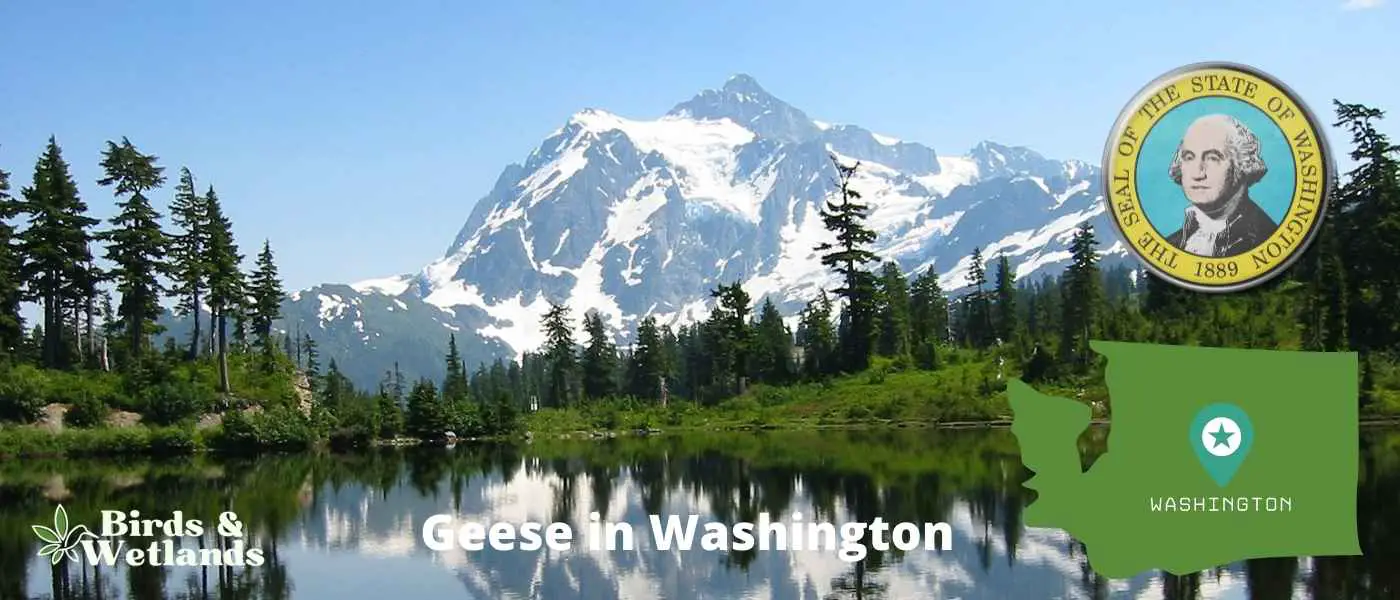There are many different types of geese in the state of Washington, and they can be found in many different places.
Some people may see them at a park or a golf course, while others may see them on the side of the road.
No matter where you see them, it’s always interesting to take a look at these beautiful creatures.
What Geese Are in Washington?
There are eight types of geese in the state of Washington.
- Canada Goose
- Snow Goose
- Ross’s Goose
- Cackling Goose
- Greater White-Fronted Goose
- Emperor Goose
- Taiga Bean Goose
- Brant
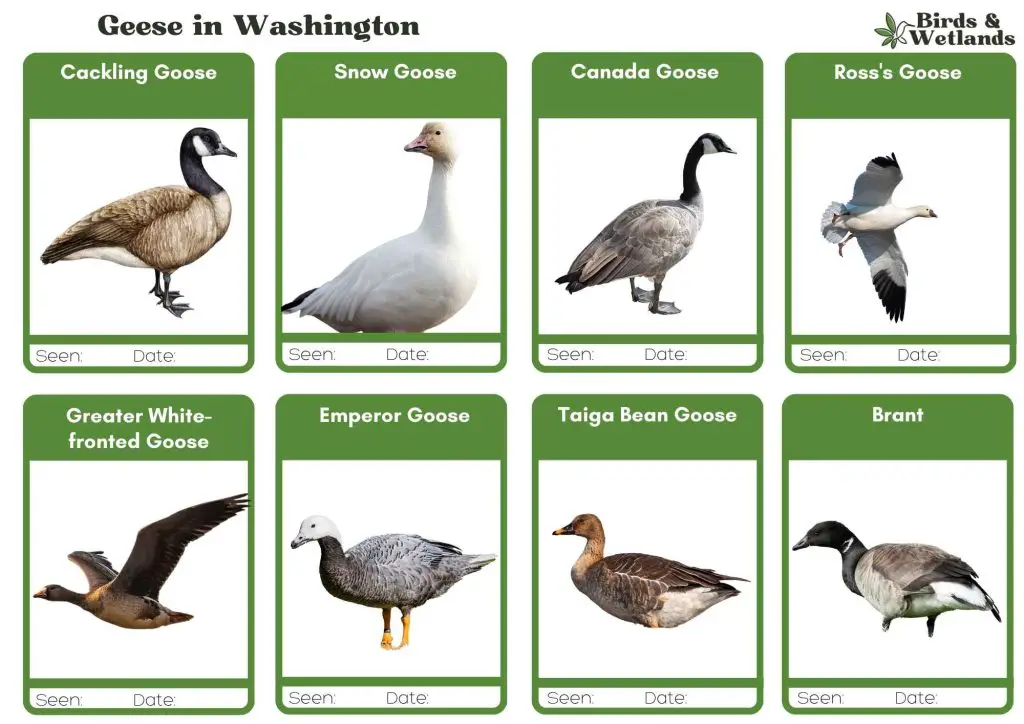
Canada Goose
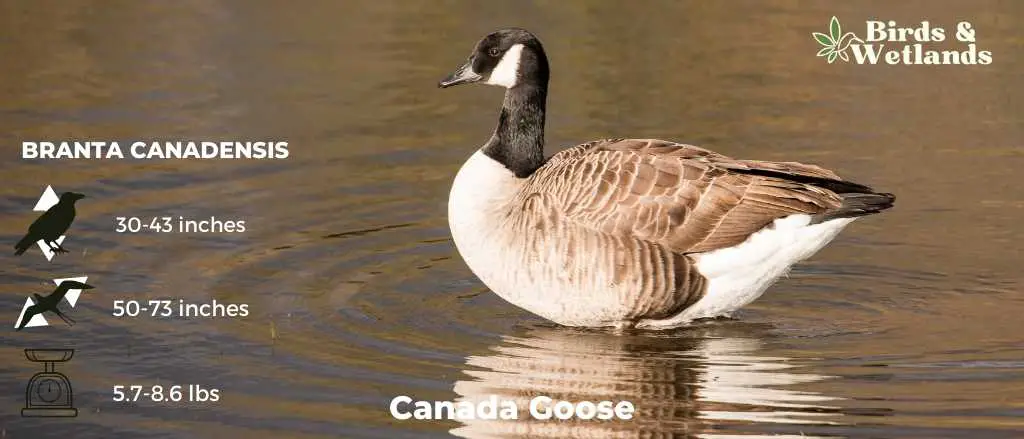
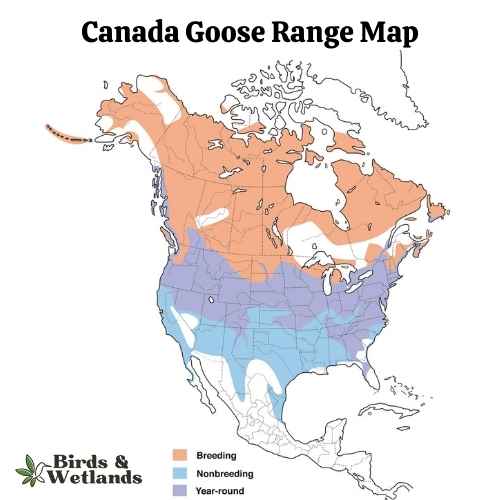
Canada Goose Sound
Scientific Name: Branta canadensis
Length: 30 to 43 in
Wingspan: 50–73 in
Weight: 5.7–14.3 lb
The Canada Goose is a large, well-known species of waterfowl noted for its distinctive appearance, familiar “honk,” and migratory behavior.
Appearance: Both male and female Canada Geese have a similar appearance, featuring a black head and neck with distinctive white patches on the cheeks and chin. The body is primarily brown with a lighter, often white, underbelly.
Diet: Canada Geese primarily feed on plant matter, including grasses, aquatic vegetation, and grains. They can often be seen grazing in parks, lawns, and fields, as well as dabbling in water bodies.
Reproduction: Canada Geese typically nest on the ground near water bodies, often on islands or other isolated areas to avoid predators. The female lays a clutch of about 4 to 6 eggs, which she incubates alone for around a month.
Snow Goose
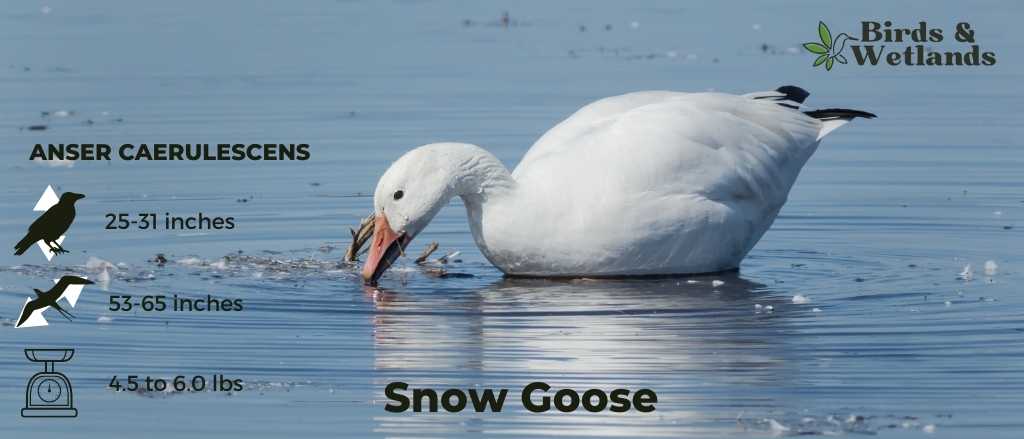
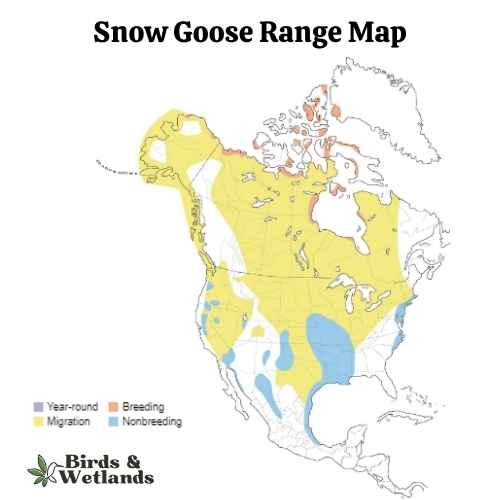
Snow Goose Sound
Scientific Name: Anser caerulescens
Length: 25 to 31 in
Wingspan: 53 to 65 in
Weight: 4.5 to 6.0
The Snow Goose is a large species of waterfowl known for its vibrant white plumage and significant migratory flights.
Appearance: True to their name, Snow Geese are predominantly white with black wingtips. They also have a pink bill, pink legs and feet. A color morph, known as the “Blue Goose,” displays a bluish-gray body with a white head, but is considered the same species.
Diet: Snow Geese primarily feed on plant matter, such as grasses, sedges, and small grains. They can often be seen in large flocks foraging in fields and marshes, and during migration and winter, they can cause considerable damage to agricultural fields due to their feeding habits.
Reproduction: Snow Geese typically nest on the tundra, near water bodies. The female builds the nest and lays a clutch of about 3 to 5 eggs, which she incubates alone for approximately three weeks. Once hatched, the goslings can feed themselves but stay with their parents for protection until they can fly.
Ross’s Goose
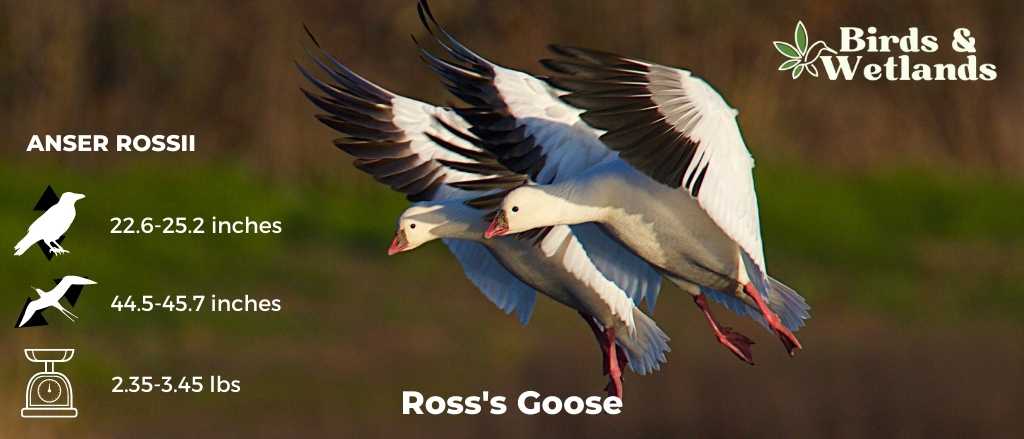
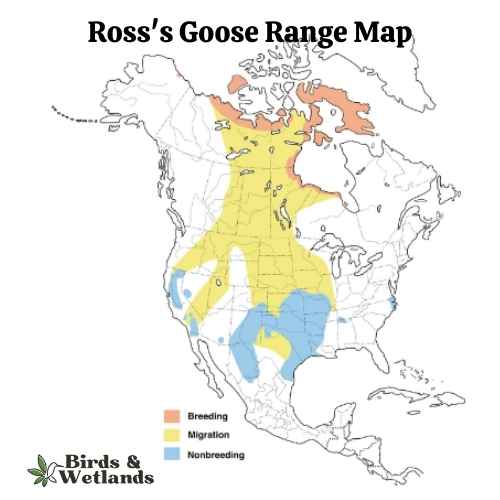
Listen
Scientific Name: Anser rossii
Length: 23.2-25.2
Wingspan: 44.5-45.7 in
Weight:42.3-55.3 oz
The Ross’s Goose is a small species of waterfowl often found in North America’s tundra and wetland habitats.
Appearance: Known for its compact size, the Ross’s Goose is mostly white with black wingtips. It features a short, stubby bill and a rounded head. One key identifying feature is the blueish gray base of its bill, which has a warty structure during the breeding season.
Diet: This goose feeds mainly on vegetation, including seeds, leaves, and roots of grasses and sedges. During winter and migration, they also consume grains and seeds from agricultural fields.
Reproduction: The Ross’s Goose nests on the ground, often in colonies. The female lays a clutch of 2 to 5 eggs which she incubates for around three weeks. The young geese, known as goslings, are precocial – they can walk, swim, and feed themselves shortly after hatching, although they stay with their parents until they learn to fly.
Cackling Goose
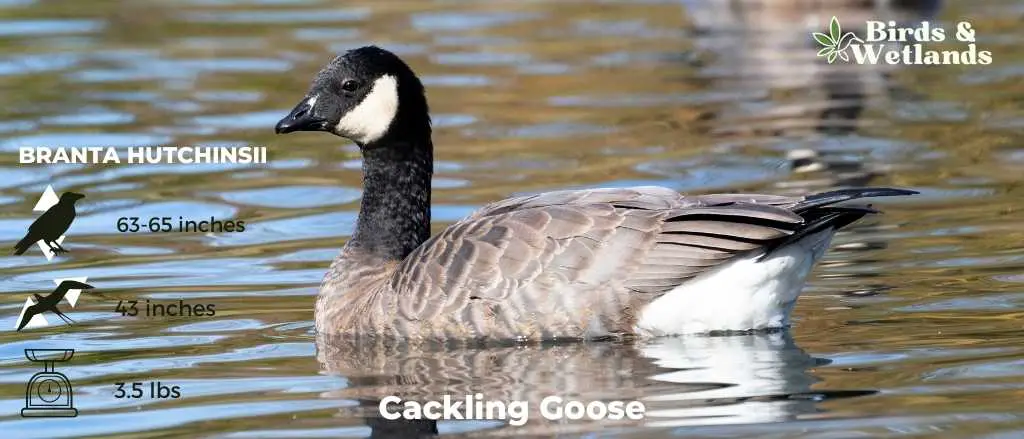
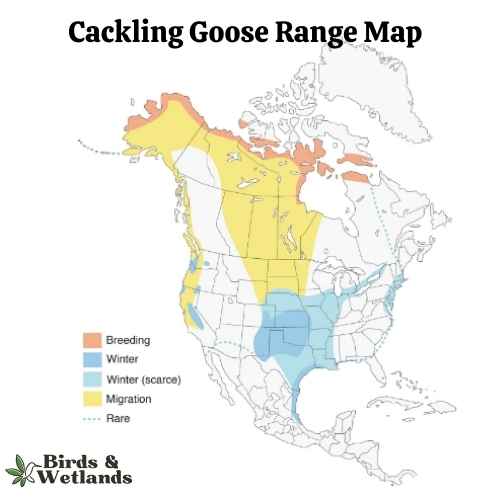
Listen
Scientific Name: Branta hutchinsii
Length: 24.8–25.6 in
Wingspan: 43-45.7 in
Weight:3.5 lbs
Cackling Geese are particularly known for their high-pitched, cackling calls, which is the source of their name. Despite their small size, these geese are renowned long-distance migrants, with some populations traveling thousands of miles between breeding and wintering grounds.
Appearance: With a similar color pattern to the larger Canada Goose, the Cackling Goose features a black head and neck, white chinstrap, light tan to cream chest, and brownish-grey body. One defining characteristic is its noticeably smaller size and stubbier neck compared to its larger counterparts.
Diet: Like many geese, the Cackling Goose’s diet mainly consists of plant matter. This includes grasses, seeds, and aquatic vegetation. They are often seen grazing on land or dabbling in shallow water.
Reproduction: Cackling Geese usually nest on the ground in elevated areas near water bodies, such as riverbanks or lakeshores. The female lays a clutch of 2 to 8 eggs and is responsible for incubation, while the male stands guard nearby. Incubation lasts for about a month.
Greater White-fronted Goose
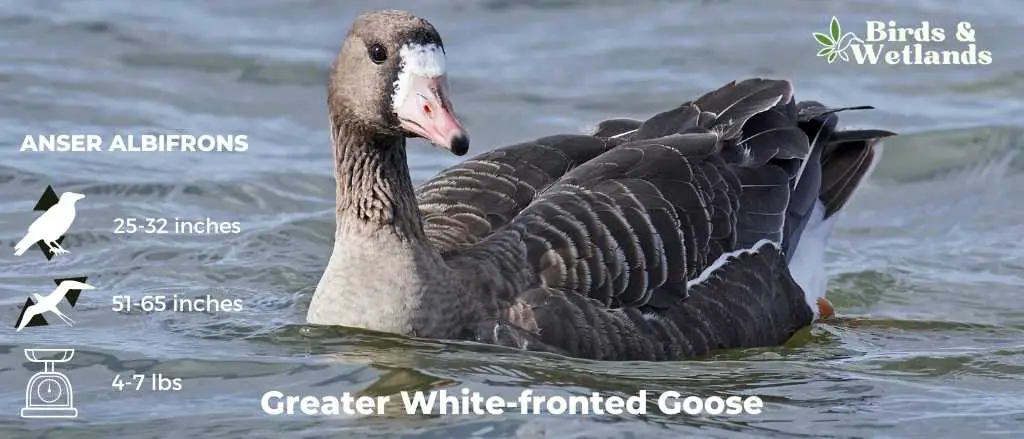
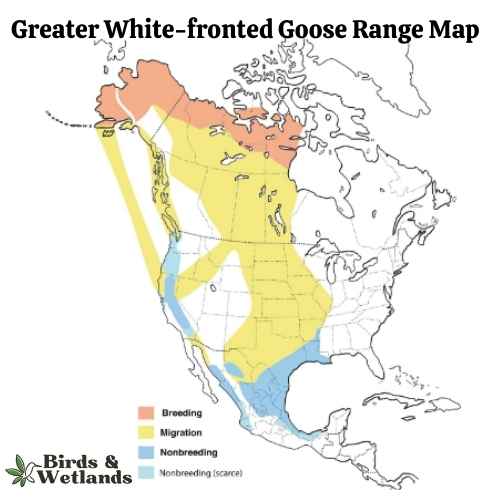
Listen
Scientific Name: Anser albifrons
Length: 25 to 31 in
Wingspan: 53 to 66 in
Weight: 3.3 to 6.6
The Greater White-fronted Goose is a medium to large waterfowl species, widely distributed across the Northern Hemisphere, particularly in North America.
Appearance: As the name suggests, these geese display a prominent white patch at the base of their bill. Their bodies are gray-brown, and their breasts are often marked with dark blotches. They possess a pinkish bill and orange legs and feet.
Diet: The Greater White-fronted Goose is a herbivore and feeds mainly on plant material. Its diet consists of grasses, sedges, grains, and berries. When wintering, these geese can often be found in agricultural fields, feasting on leftover grains and crops.
Reproduction: This species nests on the ground, often in areas with good visibility such as slopes or ridges. The female lays a clutch of 4 to 5 eggs, which she incubates for nearly a month. Once hatched, the young ones are taken care of by both parents until they are able to fly.
Emperor Goose
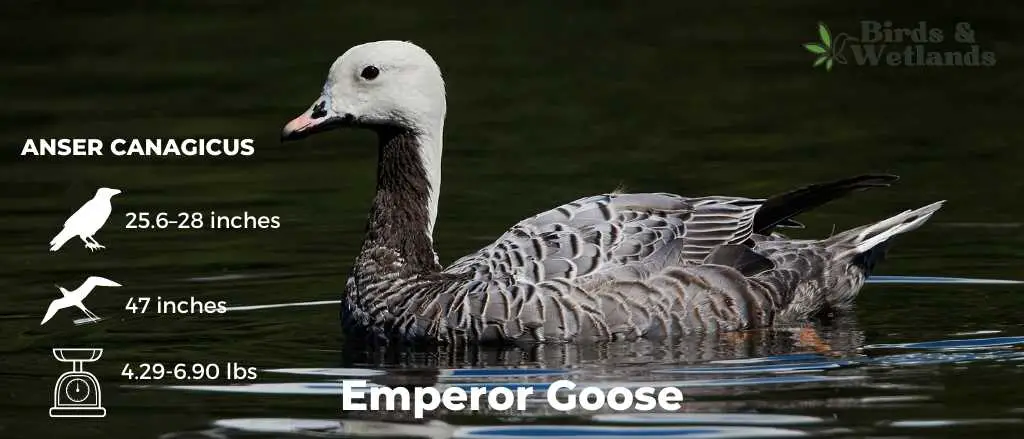
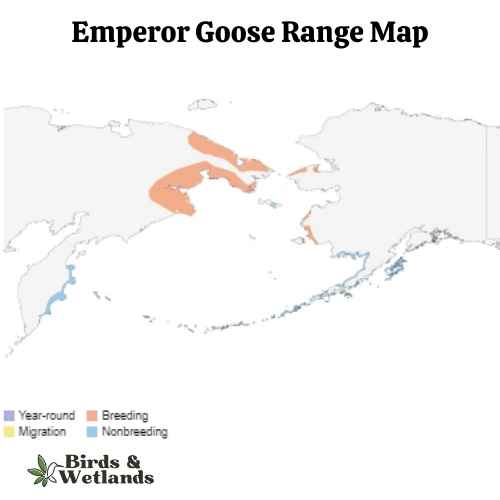
Listen:
Scientific Name: Anser canagicus
Length: 26–28 inches
Wingspan: 47 in
Weight: 4.29 lb
The Emperor Goose, also known as the beach goose or the painted goose, is one of the rarest geese in North America, and one that every birdwatcher hopes to see. This small and stocky goose is only found in Alaska. They are large birds with a wingspan of up to 4 feet and feed on the small plants in the mud at the edges of lakes and rivers, as well as roots and seeds.
The plumage is overall silvery gray, with a black and white margins making it look scaled. With a white head (which can become rust colored in the summer months), it has a black throat and its bill is small and pinkk, and the legs are orange. The sexes are similar, but juveniles have a duller plumage being gray all over.
Emperor geese need large tracts of land with patchy vegetation, water, and ample food to survive. Emperor geese use their bills to catch fish (and occasionally small mammals) while swimming in the water or flying over it. They thrive in wetland habitats because they provide the birds with food and protection from predators such as bears and wolves.
Female emperor geese lay 3-8 eggs per season in a nest made from grasses and plant material. She does the majority of incubation of the eggs, which take about 30 days to hatch.
Taiga Bean-Goose (Anser fabalis)
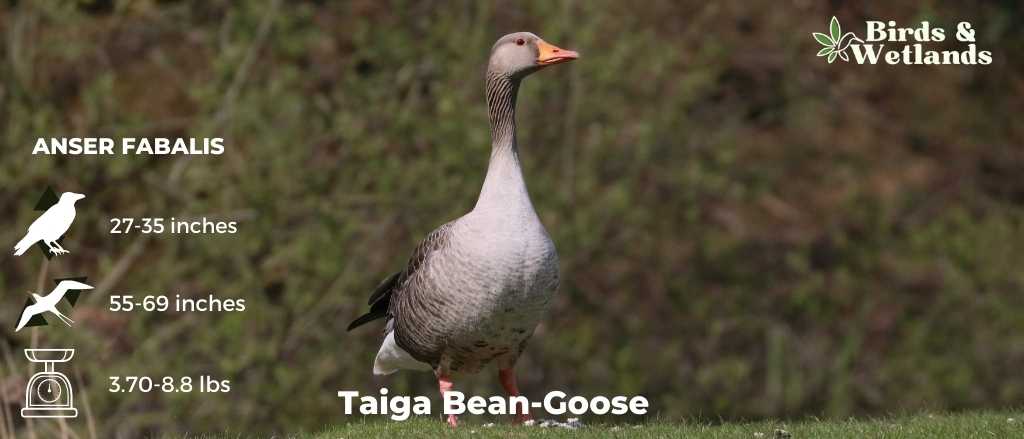
The Taiga Bean-goose is one of the rarest birds in North America. It was first observed in 1804, and it has been spotted only a handful of times since then. It is also known as the Bean Goose, Jack Snipe Goose, or Buff-breasted Goose.
- Scientific Name: Anser fabalis
- Height: 68 to 90 cm (27–35 in)
- Wingspan: 140 to 174 cm (55–69 in)
- Weight: 1.7–4 kg (3.7–8.8 lb)
Taiga Bean-Goose Description
It has black plumage on its back and brown plumage on its chest, with white on its face and neck. It also has a bright red bill and legs, which help to distinguish it from other species of goose that have similar markings but different colors on their legs or bills.
Taiga Bean-Goose Sound
Taiga Bean-Goose Habitat & Range
The Taiga Bean-Goose breeds in the taiga of northern Russia and winters in Southeast Asia, China, and Japan. It is a migratory bird that breeds in the taiga of northern Europe and Asia, with the majority of its population wintering in southeast Europe.
The Taiga Bean-goose can be found in northern Canada and Alaska during the summer months. However, they migrate southward during the winter months so they can remain warm enough to survive in these cold climates. This bird prefers to live in remote areas such as bogs or wetlands where there aren’t many humans around so that it doesn’t have to compete for food with people or other animals such as bears or wolves (which might prey upon them).
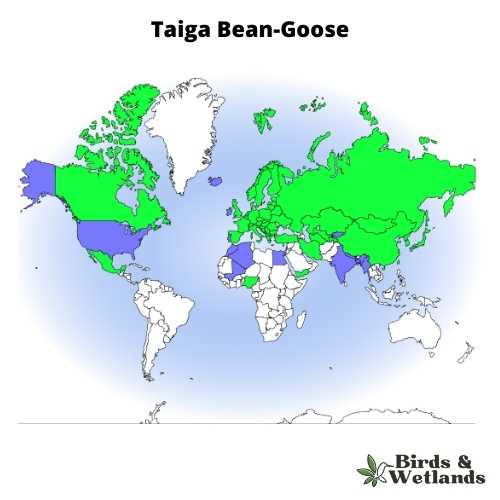
Taiga Bean-Goose Diet
The Taiga Bean-Goose feeds on plants like sedges and grass, which they find by digging through snow or using their bill to probe beneath it. Their diet also includes insects like grasshoppers, snails, and worms. These birds have an average lifespan of 20 years, but some have been known to live as long as 40 years!
This bird prefers cold climates—its range includes tundra and taiga forests that are above the tree line in the northern hemisphere. It breeds in these areas and migrates south during winter.
Taiga Bean-Goose Nesting
The Taiga Bean Goose is a protected species in Canada as well as many other countries throughout Europe and Asia. It’s one of the most common species of geese found throughout these areas, so it’s very important that we continue protecting them so that they don’t become extinct!
Brant
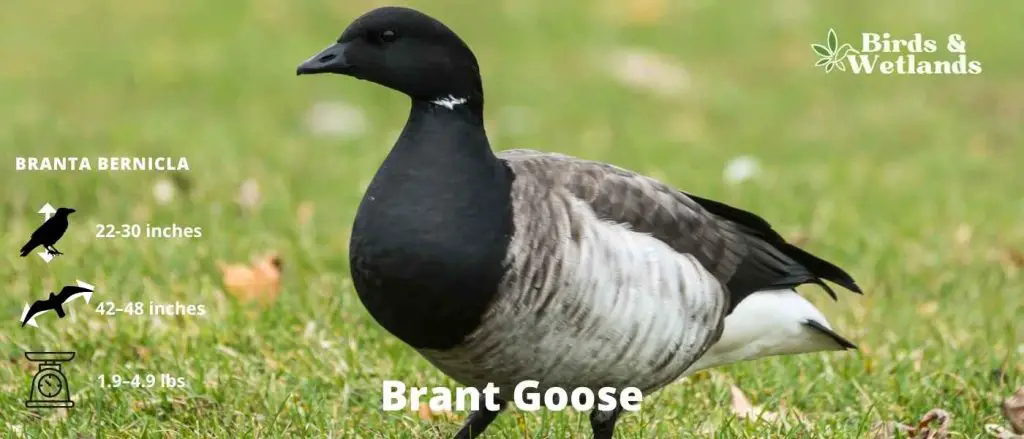
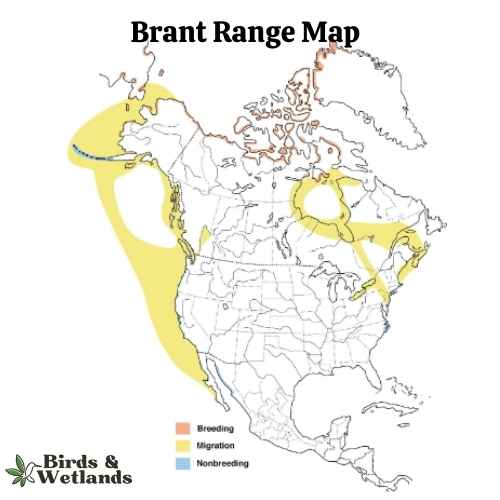
Listen
Scientific Name: Branta bernicla
Length: 22–26 in
Wingspan: 42–48 in
Weight: 1.9–4.9 lb
The Brant is a compact species of goose that is known for its striking appearance and interesting migratory patterns.
Appearance: The Brant is recognized for its dark, sooty color with a white crescent on the neck. The body is mostly black to dark gray, contrasting with the lighter underparts. Its small size, as compared to other geese, and short, stubby bill are other distinct features.
Diet: The Brant’s diet primarily consists of aquatic plants, especially eelgrass and sea lettuce. During the breeding season, they may also feed on grasses, sedges, and insects.
Reproduction: Brants typically breed in the high Arctic tundra. The female lays a clutch of 3 to 5 eggs in a ground nest, which she incubates for about a month.
Notably, Brants make an impressive long-distance migration every year. They spend their winters along both the east and west coasts of the United States and travel to the Arctic regions of Canada, Alaska, and even Russia to breed.
Where to Watch Geese in WA?
Geese are a common sight in Washington, and they can be found in a variety of habitats.
However, the best place to see geese is in Skagit Valley.
This area is home to a large population of geese, and it is known for its beautiful wetlands. In addition, Skagit Valley is an excellent place for birdwatching, as it is home to a variety of other bird species.
Snow geese spend their summers on Wrangel Island where they have their nest sites.
It’s truly impressive that hundreds of winter snow geese travel thousands of miles from their breeding grounds in Wrangel Island in Russia to spend their winter months in their wintering grounds in Western Washington.
Some of these water birds travel further south towards California’s Central Valley.
Are There Any Resident Flocks of Geese in the State of Washington?
Washington is home to a large population of resident Canada geese.
These geese have adapted to living in a range of habitats, from open farmland to urban parks. In the winter months, they can be found in sheltered areas near water, such as lakes, rivers, and coastal marshes.
As the weather warms up, they move to higher elevations in search of food.
In the summer months, they can be found in mountain meadows and forested areas.
No matter where they are living, resident Canada geese need access to water so that they can drink and bathe. They also prefer areas with plenty of grass so that they can graze on the aquatic vegetation.
Geese Hunting in Washington
Waterfowl hunting is a popular pastime in Washington, and the state is home to a variety of different species of geese.
In order to hunt geese in Washington, you will need to purchase a small game license from the WDFW.
If you are 16 or older, you must also purchase a Washington Department of Fish and Wildlife (WDFW) migratory bird permit and a federal duck stamp.
These requirements are in place to help protect waterfowl populations and ensure that hunters are properly trained and equipped.
In addition, all hunters must adhere to the state’s hunting regulations, which are designed to promote safety and conservation.
Can You Shoot Geese in WA?
In Washington, it is illegal to shoot geese with a shotgun that can hold more than three shells.
This is because excessive gunfire can scare away other birds and disturb the peace of the area.
In addition, all waterfowl hunting requires the use of non-toxic shots such as steel. This is to protect the environment from lead poisoning.
Additionally, all waterfowl hunters should be aware of Washinton’s daily bag and possession limits.
Where Can I Hunt Geese in WA?
Hunting geese can be a rewarding experience, and Washington state provides ample opportunity for success.
In terms of sheer numbers, Grant County is the best place to hunt geese, with Franklin, Benton, Skagit, Yakima, Walla Walla and Spokane counties also providing good populations.
But hunters should also keep in mind that different types of geese inhabit different areas.
Is There a Goose Hunting Season in Washington?
Goose hunting season in Washington runs from September to January, giving hunters ample opportunity to bag a bird or two.
During this time, geese are particularly active, making them easy targets for skilled hunters.
Conclusion on Geese in WA
Washington is a great place to be for bird watchers and hunters alike.
With eight types of geese, there are plenty of opportunities to see these beautiful creatures in the wild.
The state also offers many hunting areas where you can bag yourself a goose or two.
If you’re looking for an amazing bird-watching experience while they fly overhead or some good old-fashioned goose hunting, Washington is the place to be!

